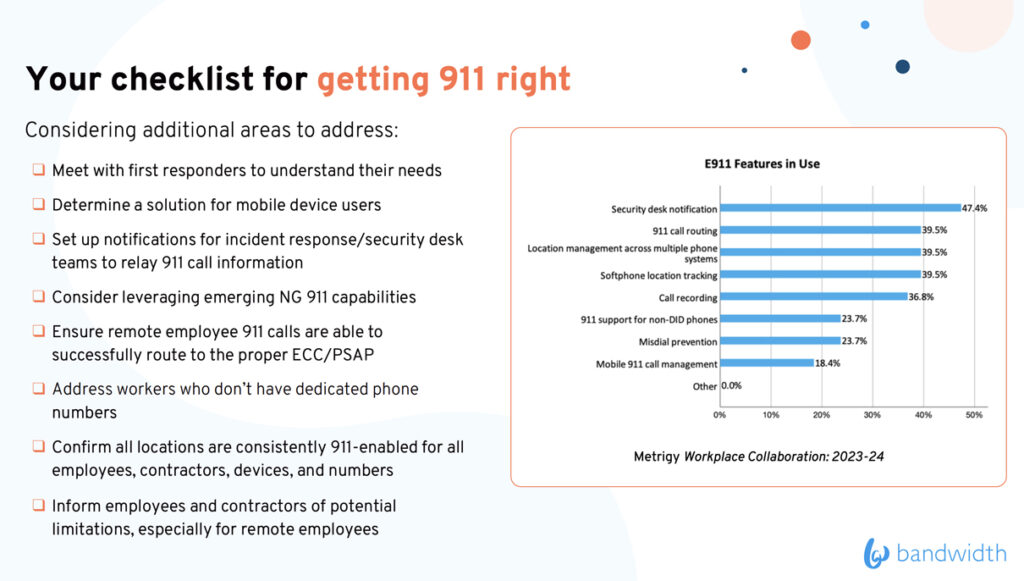When planning a new 911 deployment, enterprises today face a challenging question: Can you pinpoint the exact location of workers at the time of an emergency call? With more employees working from home, using hot desks in the office or logging in from remote locations, it is more difficult than ever to be sure those calls are routed quickly to the appropriate local public-safety answering point (PSAP). It’s an even bigger challenge when you factor in a variety of on-premise, hybrid and cloud platforms now in use in large organizations.

Three years after implementation of Kari’s Law and a year after the latest deadline for Ray Baum’s Act, many U.S. organizations are still wrestling with the complexities of these 911 federal regulations, according to Irwin Lazar, president and principal analyst, Metrigy.
“There is a lack of clarity as to what it means to be compliant, and many organizations are still trying to figure it out,” said Lazar at an Enterprise Connect webinar on January 25, “Getting 911 Right: How to Ensure Compliance, Minimize Risk and Protect Employee Safety in the Hybrid Workplace,” sponsored by Bandwidth and hosted by Eric Krapf, general manager, Enterprise Connect.
Panelist Robin Erkkila, sales engineer E911 and Emergency, Bandwidth, noted that Kari’s Law and the Ray Baum Act direct the Federal Communications Commission (FCC) to form 911 regulations for multiline telephone system (MLTS) operators, including enterprises.
“Unless you’re running a legacy Nortel system that hasn’t been touched for several years, you are considered an MTLS operator,” he said. “If you have deployed MS Teams or another new solution, you will need to adhere to these regulations.”
While the recently implemented rules say that a dispatchable location must be delivered to the PSP, they don’t specify how that should be done, providing flexibility in designing solutions. “The regulations came out before the pandemic, so they didn’t deal with the work-from-home and hybrid work environments,” Erkkila added. “But you need to take the remote workforce into account in designing your solution.”
Practical suggestions
Lazar and Erkkila presented a three-step process for 911 deployments, and added a few more practical suggestions, emphasizing the importance of contacting legal counsel. “There may be state or local regulations regarding 911 calls, as well as the federal rules,” said Lazar. “You need to understand what’s necessary to be in compliance.”
• Step 1: Map out your current (and future) 911 stack. You need to connect your communications stack to a routing layer that can send 911 calls to the right PSAP, said Erkkila. That is a challenge in an enterprise environment with multiple geographic locations and vendor solutions. “You need different interfaces to make those solutions work, and as you migrate from on-prem platforms to the cloud, you may need to tweak your 911 system,” he said.
• Step 2: Determine the right E911 network solution. Youneed to provision services and make emergency calls in a way that is right for your organization. For instance, a 911 call from an employee’s mobile phone in Denver routed through the organization’s headquarters in Omaha, needs to reach a local PSAP near the employee – not in Nebraska.
• Step 3: Leverage software for self-provisioning locations. Be sure your solution can support the requirements for users of non-fixed endpoints to be 911 enabled. Consider adding automated capabilities to address this challenge, said Erkkila. Remember that you also need to provision for visiting guests and contractors as well as employees.
Other tips for getting 911 right include meeting with local first responders to understand their needs. “You also need to set up notifications for incident response and security teams to relay 911 call information,” said Lazar. Employees should be educated on the potential limitations of your 911 system, especially in WFH or other remote work locations.
Summarizing the session, Erkkila said, “Overall, Kari’s Law and Ray Baum’s Act work together to impact public safety. You need to take steps to ensure that employee safety is paramount.”